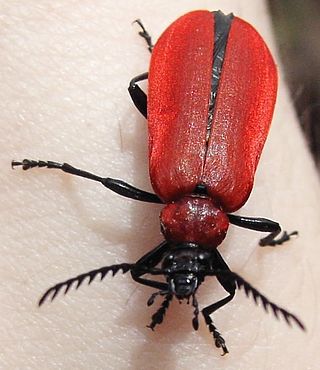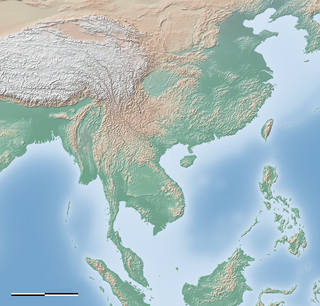
Genus is a taxonomic rank above species and below family as used in the biological classification of living and fossil organisms as well as viruses. In binomial nomenclature, the genus name forms the first part of the binomial species name for each species within the genus.

Fire-coloured beetles is the common name for members of the tenebrionoid family Pyrochroidae. The family is found worldwide, and is most diverse at temperate latitudes. Adults measure 2–20 millimetres (0.079–0.787 in); larvae reach 35 millimetres (1.4 in). Larvae of Pyrochroinae are found associated with the bark of dead trees. They are probably mostly fungivorous, although they may become cannibalistic if too crowded.

Heteroceridae, the variegated mud-loving beetles, are a widespread and relatively common family of beetles found on every continent except for Antarctica.

The Ochteridae comprise a small family of insects. Eight genera with about 80 species have been described. They occur worldwide along the shore of various types of water and the greatest diversity is in tropical regions. They are "true bugs", being members of the order Hemiptera, and are in the suborder Heteroptera. Ochteridae commonly are known as the velvety shore bugs. They resemble the Saldidae shore bugs and have lengths ranging from 4.5 to 9 mm (0.18–0.35 in).
Eremiaphila brunneri is a species of praying mantis in the family Eremiaphilidae. They are located in and around Israel.

Xyletobius is a genus of beetles in the family Ptinidae.
Euborellia brunneri is a species of earwig in the family Anisolabididae.
Tachina brunneri is a species of fly in the genus Tachina of the family Tachinidae that is endemic to Serbia.

iNaturalist is an American 501(c)(3) nonprofit social network of naturalists, citizen scientists, and biologists built on the concept of mapping and sharing observations of biodiversity across the globe. iNaturalist may be accessed via its website or from its mobile applications. iNaturalist includes an automated species identification tool, and users further assist each other in identifying organisms from photographs and even sound recordings. As of 9 July 2024, iNaturalist users had contributed approximately 197,660,888 observations of plants, animals, fungi, and other organisms worldwide, and 290,007 users were active in the previous 30 days.
Limonium jovibarba is a species of flowering plants of the family Plumbaginaceae. The species is endemic to Cape Verde. It is listed as critically endangered by the IUCN. The species was named by Carl Ernst Otto Kunze in 1891. Its local name is carqueja, a name that may also refer to the related species Limonium brunneri and Limonium braunii.
Limonium brunneri is a species of flowering plants of the family Plumbaginaceae. The species is endemic to Cape Verde. It is listed as critically endangered by the IUCN. The species was named by Carl Ernst Otto Kunze in 1891. Its local name is carqueja, a name that may also refer to the related species Limonium braunii and Limonium jovibarba.
Pamphagodidae is a small family of grasshoppers in the Orthoptera: suborder Caelifera. Species in this family can be found in southern Africa and Morocco.

Atlanticus is a genus of "eastern shieldback" bush crickets or katydids in the tribe Drymadusini. It has a discontinuous recorded distribution in North America and temperate eastern Asia.
Paratylotropidia is a genus of spur-throated grasshoppers in the family Acrididae. There are at least three described species in Paratylotropidia.
Paratylotropidia morsei is a species of spur-throated grasshopper in the family Acrididae. It is found in North America.
Tetrix brunnerii, known generally as the Brunner's pygmy grasshopper or Brunner's grouse locust, is a species of pygmy grasshopper in the family Tetrigidae. It is found in North America.

Gonypeta is an Asian genus of praying mantids: in the subfamily Gonypetinae.

Deiphobe is an Asian genus of praying mantids: in the family Rivetinidae.
Chloracris is an Asian genus of bush-crickets in the tribe Pseudophyllini and the subfamily Pseudophyllinae.
Lotus brunneri is a subshrub in the genus Lotus endemic to Cape Verde.








